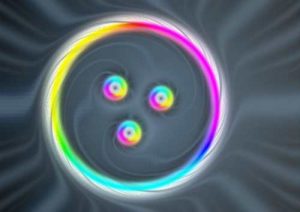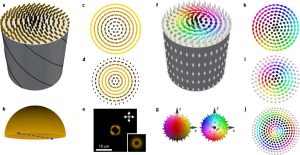R&D: Skyrmions Could Provide Next Gen Storage
Universities of Birmingham, Bristol and Colorado Boulder' scientists moved step closer to developing storage and processing devices, using emerging sciences.
This is a Press Release edited by StorageNewsletter.com on April 30, 2019 at 2:10 pmScientists at the Universities of Birmingham, Bristol and Colorado Boulder have moved a step closer to developing the next generation of data storage and processing devices, using an emerging science called skyrmionics.
Simulation of skyrmion bags in magnetic materials
Skyrmionics focuses on harnessing the properties of nanometer-sized structures in magnetic films called skyrmions. These spin on the surface of the magnet like tiny vortices, and scientists believe they could be used to store much denser quantities of data than is currently possible using existing magnetic data storage techniques on which modern computers currently rely.
The shape of these skyrmion structures means data encoded in them could also be transferred using much less power than is currently achievable.
But arranging these new structures in a way that makes them capable of storing and transferring data has proved a challenge.
In a study, published in Nature Physics, the research team of UK-based theorists and US-based experimentalists has demonstrated a way of combining multiple skyrmions together in structures they call ‘skyrmion bags’, which allows a far greater packing of information in skyrmion systems.
“The challenge of improving our data storage is becoming increasingly urgent,” explains Mark Dennis, professor, theoretical physics, University of Birmingham, and lead author of the study. “We will need new technological approaches to increase the amount of data we want to store in our computers, phones and other devices, and skyrmion bags might be a route to this. Rather than using trains of single skyrmions to encode binary bits, each skyrmion bag can hold any number of skyrmions, massively increasing the potential for data storage.”
The team have modelled their technique in magnetic devices using computer simulations, and successfully tested it in experiments involving liquid crystals.
“It’s particularly exciting to see this technology at work in liquid crystal since it opens up new possibilities for advances in areas such as display screens, sensors or even solar cells,” adds Dr David Foster, co-lead author, University of Bristol.
Skyrmions were originally proposed as a theoretical model of fundamental particles by Professor Tony Skyrme of the University of Birmingham in the 1960s. This research, funded by the Leverhulme Trust and the US Department of Energy, demonstrates how purely theoretical ideas in physics can lead to innovative new technologies.
In February, the University of Birmingham secured funding from the Engineering and Physical Sciences Research Council (EPSRC) for a new £ multi-million Centre for Doctoral Training in Topological Design at the University of Birmingham. The centre is expected to train students, in collaboration with industrial partners, to deliver breakthroughs in the shape-related structures leading to new technologies such as skyrmionics.
Article: Two-dimensional skyrmion bags in liquid crystals and ferromagnets
Nature Physics has published an article writed by David Foster, H. H. Wills Physics Laboratory, University of Bristol, Bristol, UK, Charles Kind, School of Mathematics, University of Bristol, Bristol, UK, Paul J. Ackerman, Department of Physics and Soft Materials Research Center, University of Colorado, Boulder, CO, USA, Jung-Shen B. Tai, Department of Physics and Soft Materials Research Center, University of Colorado, Boulder, CO, USA, Mark R. Dennis, H. H. Wills Physics Laboratory, University of Bristol, Bristol, UK, and School of Physics and Astronomy, University of Birmingham, Birmingham, UK, Ivan I. Smalyukh, Department of Physics and Soft Materials Research Center, University of Colorado, Boulder, CO, USA, and Department of Electrical, Computer, and Energy Engineering, Materials Science and Engineering Program, University of Colorado, Boulder, CO, USA, and Renewable and Sustainable Energy Institute, National Renewable Energy Laboratory and University of Colorado, Boulder, CO, USA.
Solitonic structures of a fractional skyrmion, skyrmion and skyrmionium
a, A translationally invariant quarter-skyrmion tube with n(x), visualized by rods whose colour is based on their orientations in the S2/Z2 order-parameter space shown in b. b, The colour scheme for n(x) in a–e determined by orientations in S2/Z2, where diametrically opposite points around the base of a hemisphere are identified. c,d, Top views of a half-skyrmion (c) and an elementary full skyrmion (d) in the director field. e, A polarizing optical micrograph of a LC skyrmion. The computer visualization based on the colour scheme in b is shown in the inset. f, A translationally invariant skyrmion tube visualized by coloured arrows smoothly decorating n(x) based on their orientations on the S2 sphere in g. g, The Runge colour sphere is used for the vectors in f–j, with hues and brightness determined by the representation of n(x) on S2, viewing from the side and from above. h–j, Top views of a vector-field half-skyrmion (h), full skyrmion (i) and skyrmionium (j).
Click to enlarge
Abstract: “Reconfigurable, ordered matter offers great potential for future low-power computer memory by storing information in energetically stable configurations. Among these, skyrmions—which are topologically protected, robust excitations that have been demonstrated in chiral magnets1,2,3,4 and in liquid crystals5,6,7 are driving much excitement about potential spintronic applications8. These information-encoding structures topologically resemble field configurations in many other branches of physics and have a rich history9, although chiral condensed-matter systems so far have yielded realizations only of elementary full and fractional skyrmions. Here we describe stable, high-degree multi-skyrmion configurations where an arbitrary number of antiskyrmions are contained within a larger skyrmion. We call these structures skyrmion bags. We demonstrate them experimentally and numerically in liquid crystals and numerically in micromagnetic simulations either without or with magnetostatic effects. We find that skyrmion bags act like single skyrmions in pairwise interaction and under the influence of current in magnetic materials, and are thus an exciting proposition for topological magnetic storage and logic devices.“















 Subscribe to our free daily newsletter
Subscribe to our free daily newsletter

